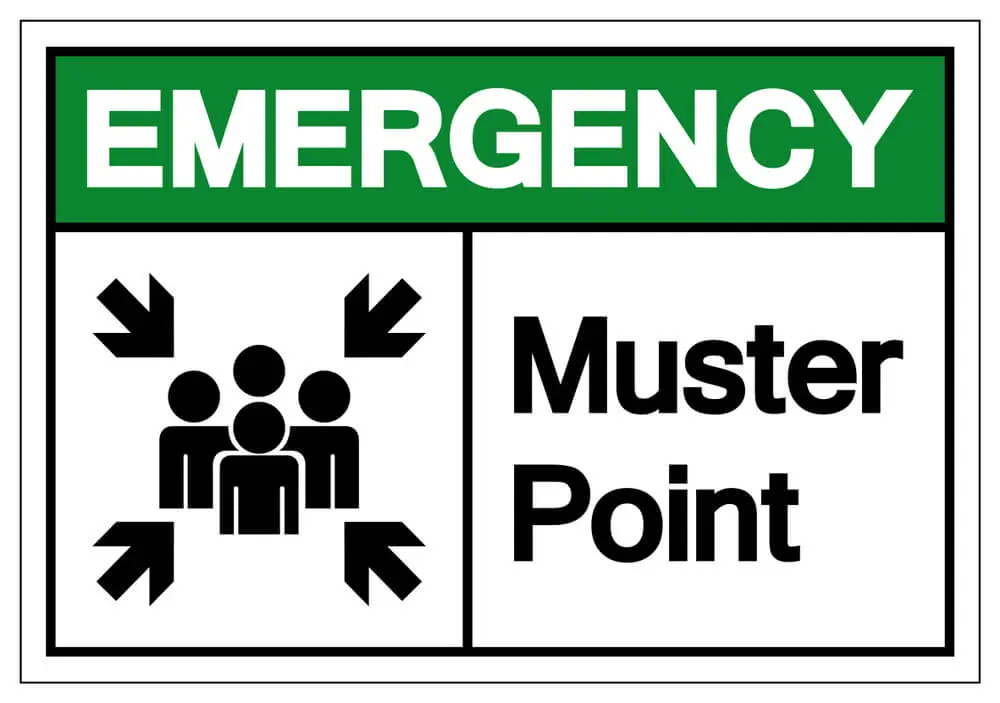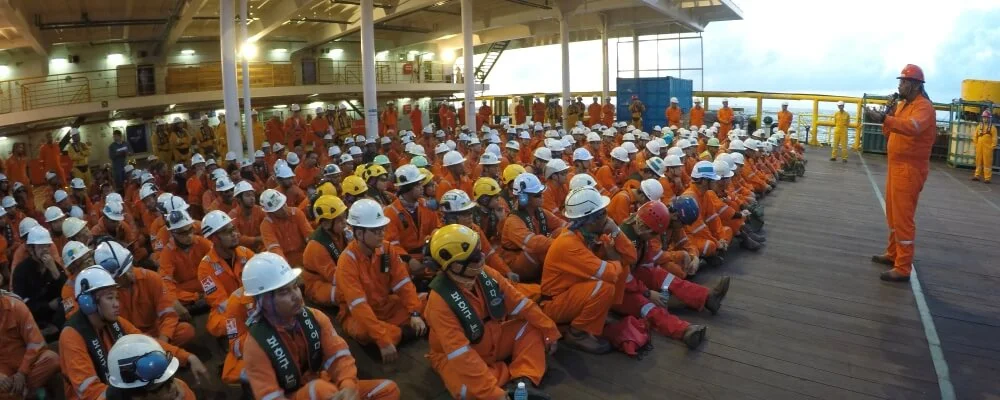Understanding the critical aspects of workplace safety is paramount for any organization. One such crucial element is the muster point, a life-saving component during emergencies that often goes unnoticed in daily operations. In this blog post, we dive into the meaning and significance of the muster point in the emergency management landscape. We’ll guide you through the universally recognized symbols and signs that mark these vital locations and explain how to identify them.
A critical part of this discussion revolves around strategically selecting a muster point’s location. It isn’t about choosing any available spot; specific considerations are necessary to ensure maximum safety during crises. So, the principles we discuss here are universally applicable whether you’re navigating safety protocols in a high-paced corporate environment, an extensive industrial facility, or a compact retail space. Join us on this informative exploration to enhance your knowledge and contribute effectively to your organization’s safety initiatives.
What’s Muster Point?
A muster point is a pre-determined location or area where all the employees, visitors, or individuals present in a facility or a workplace are instructed to assemble in case of an emergency or evacuation. The primary purpose of a muster point is to ensure that everyone is safe and accounted for during an emergency.
Muster points are usually identified during the emergency planning process, and they are chosen based on their safety, size, distance from potential hazards, and accessibility for all individuals, including those with physical disabilities. These muster points’ locations are often clearly marked with signs, and information about them is typically included in safety briefings, evacuation plans, and employee training.
Everyone must go directly to the muster point during an evacuation to be accounted for. Roll calls or head counts are usually performed at muster points to determine if everyone has safely evacuated the premises. In some cases, first aid or other emergency support may also be provided at these locations.
Regular safety drills are often conducted to ensure everyone in the facility knows where the muster points are located and how to reach them in an emergency. This not only ensures familiarity with the evacuation process but can also identify potential issues or improvements that can be made to the emergency plan.

Importance Of Muster Point
Muster points are critical in maintaining safety and order during an emergency. They are vital for several reasons:
- Accountability: Muster points provide a location where everyone can be accounted for during an emergency. Once everyone is gathered at the muster point, a head count or roll call can be taken to ensure everyone is safe and no one is missing or left behind.
- Safety: The risk of injury or harm during an emergency can be significantly reduced by directing everyone to a designated area that has been determined to be safe and away from potential hazards.
- Efficient evacuation: Having a predetermined muster point simplifies the evacuation process. Everyone knows where to go and doesn’t have to think about where to head during a stressful and potentially chaotic situation.
- Emergency response: Muster points serve as a central location where emergency instructions can be given, and updates can be shared. They are also places where first aid can be administered if necessary.
- Controlled re-entry: After the emergency, control over when and how people re-enter the affected area can be managed from the muster point. This helps ensure that it’s safe to re-enter and that this process is orderly.
- Compliance: In many jurisdictions, having clear emergency evacuation procedures, including designated muster points, is a legal requirement for businesses. This compliance helps ensure a minimum level of safety for all building occupants.
Regular drills and training should be carried out to ensure everyone is familiar with the location of the muster points and the procedures to follow during an evacuation. This can greatly enhance the effectiveness of muster points during an actual emergency.
Difference Between A Muster Point And An Assembly Point
Muster and assembly points serve as critical gathering locations during an emergency, but they have slightly different purposes and characteristics.
A muster point is a single, pre-designated spot where all employees and visitors are instructed to congregate during an emergency. It is typically well-marked and known to everyone in the organization, serving as a universal rendezvous point regardless of where one may be within the facility at the time of the incident.
On the other hand, an assembly point refers to multiple locations spread across the workplace, usually designated by department or area within the facility. These points serve a similar purpose to the muster point in providing a location for individuals to gather during an emergency. Still, they also function as hubs for information updates from emergency responders. In addition, assembly points often feature amenities such as access to washrooms and shelter from the elements, providing comfort during a potentially stressful situation.
While both serve as critical gathering spots during emergencies, a muster point is typically a single, organization-wide meeting place. In contrast, assembly points are numerous, localized gathering spots designed to cater to specific organizational areas or departments.
Muster Point Signs

Muster point signs are important for clearly indicating the location of the muster points in a facility or workplace. These signs are designed to be highly visible and easily understood, even from a distance. They typically follow certain standards to be universally recognizable. Here are some general characteristics of muster point signs:
- Color scheme: The sign usually has a green and white color scheme, internationally recognized colors for safety and first aid signs.
- Iconography: The sign typically features an icon or graphic of a group of people gathered together. This helps visually communicate that the area is a gathering point during emergencies.
- Text: The sign usually includes “Muster Point.” This text can be in multiple languages, depending on the local requirements and the diversity of the employees or visitors to the site.
- Arrows: Some muster point signs include arrows pointing towards the center of the icon, indicating that people should gather at that spot.
It’s important to place muster point signs at eye level and in clear view to ensure they can be easily seen. They should also be made of durable materials to withstand various weather conditions, particularly if the muster point is outdoors.
Moreover, all employees and visitors should be briefed about the meaning of these signs and what to do when they see them. Regular drills and evacuation exercises can further help familiarize everyone with the location of the muster points and the procedures to follow in an emergency.
What’s Right Location For Muster Points
The location of muster points is crucial to ensuring the safety and efficiency of an evacuation during an emergency. Here are some guidelines for choosing the right locations:
- Safe Surroundings: The muster point should be located in an area free of potential hazards. It should be away from heavy traffic, tall structures, power lines, trees that can be knocked down by heavy winds, and areas that can flood during a heavy rainstorm.
- Safe Distance: The muster point should be safe from the building or site being evacuated. A common guideline is to set the muster point at least one-and-a-half times the height of the tallest building away. This helps protect individuals from hazards such as fire, explosions, or flying debris.
- Accessibility: The muster point should be easily accessible to everyone, including those with physical disabilities, pregnant women, the elderly, and anyone with limited mobility. Avoid locations that require climbing stairs, navigating steep inclines, or overcoming other physical obstacles.
- Size: The muster point should be large enough to accommodate all personnel, visitors, and contractors. Overcrowding can lead to confusion and increase the risk of injury, so multiple muster points may be necessary if the worksite is large or densely populated.
- Visibility: The muster point should be easily visible or well-marked so people can find it quickly and easily. It should not be hidden behind structures or in an obscure location.
Remember, the best location for a muster point may vary depending on the specifics of your worksite, such as its size, the number of employees, and the nature of the work conducted. Regular safety drills can help ensure that the chosen locations are effective and make any necessary adjustments based on the results of these drills.

Role of Muster Points in Emergency Procedures
Muster points are integral to emergency procedures and vital to any comprehensive emergency evacuation plan. Here’s how they are typically integrated and used:
1. Integration of Muster Points into Emergency Evacuation Plans:
Muster points are pre-determined locations where everyone on site is instructed to gather in case of an emergency. Their locations should be carefully selected to ensure they are safe, accessible, and spacious enough to accommodate everyone.
Once identified, these locations are integrated into the emergency evacuation plans. These plans outline the quickest and safest routes to the muster points from various locations within the premises. The information about the muster points and evacuation routes is communicated to all personnel through safety briefings, signage, and training exercises.
2. Use of Muster Points in Different Types of Emergencies:
The role of muster points remains consistent across different types of emergencies, be it a fire, chemical spill, natural disaster, or security threat. In all cases, the primary objective is to get everyone away from danger and to a safe location as quickly and orderly as possible.
The type of emergency might influence the selection of a particular muster point. For example, in the event of a chemical spill, the muster point should be upwind of the spill to avoid exposure to hazardous fumes. Similarly, in the case of a fire, the muster point should be located a safe distance from the building to avoid exposure to heat and smoke.
3. The Role of Muster Points in Headcounts and Accounting for All Personnel:
Once everyone has gathered at the muster point, a headcount or roll call is taken to ensure everyone is safe and accounted for. This step is crucial as it can quickly identify if someone is missing and potentially still in danger.
In large organizations, department heads or team leaders are usually tasked with accounting for their team members. Once all individuals are accounted for, the information is relayed to the emergency services and the incident commander to ensure a coordinated and informed response. Lastly, muster points also serve as a centralized location for disseminating information and updates about the emergency and the next steps, making them an essential part of any emergency response procedure.
Conclusion
In conclusion, muster points are integral to workplace safety and emergency preparedness. They serve as designated areas where individuals gather during an emergency, crucial in ensuring accountability, enabling efficient evacuation, and serving as a hub for information dissemination. Recognizable through their distinct green and white signage, featuring an icon of gathered individuals, these points must be strategically selected considering their surroundings, safe distance from potential hazards, accessibility, and size to accommodate all personnel.
By fully understanding the meaning, signs, and appropriate location of muster points, organizations can substantially improve their preparedness for emergencies, thereby ensuring the safety of their workforce.

